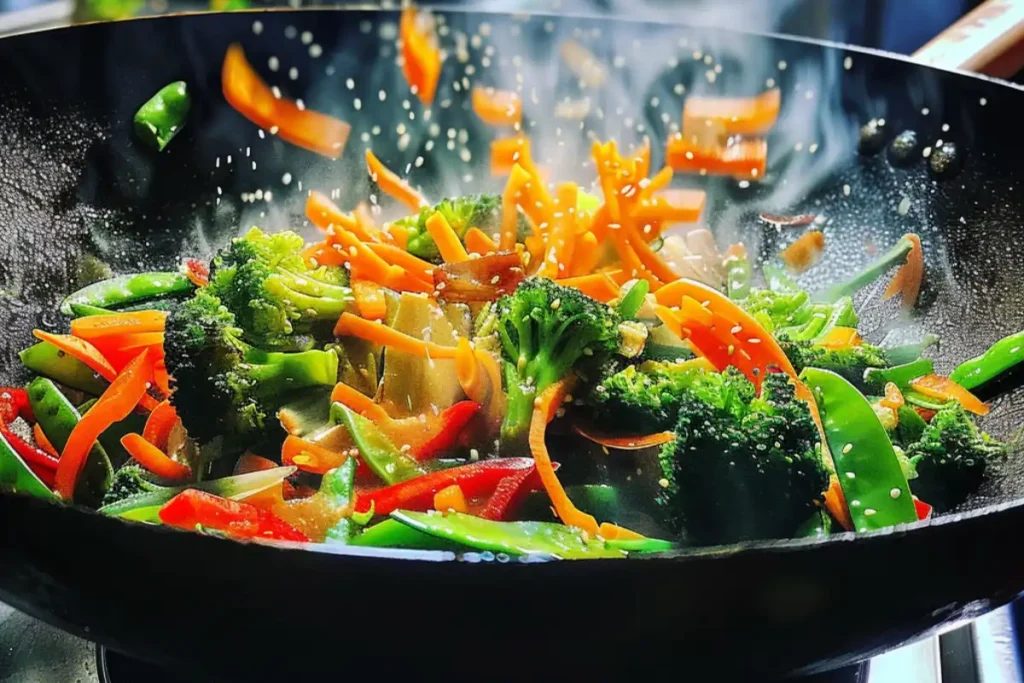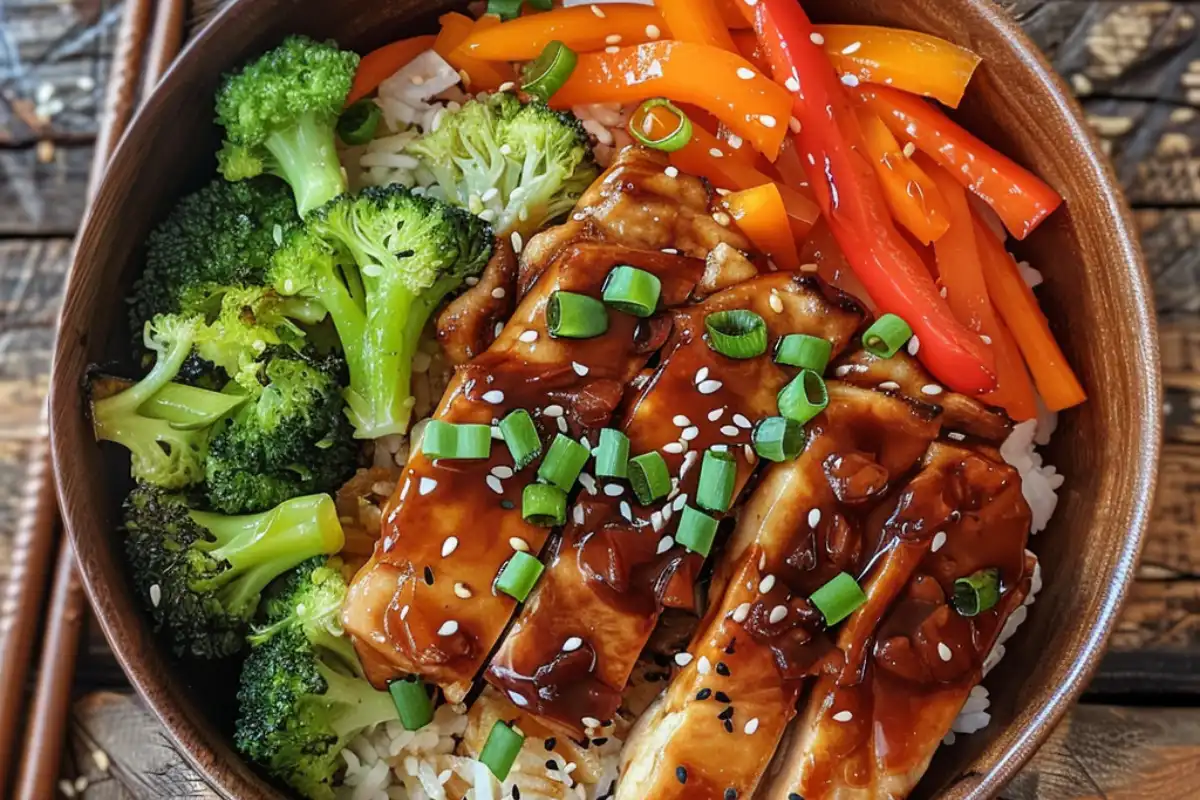A teriyaki bowl is the perfect blend of flavor, nutrition, and convenience. Whether you’re craving a quick and healthy dinner or looking to meal prep for the week, this dish offers endless customization. In this guide, we’ll cover everything you need to know to create a delicious teriyaki bowl at home, from classic recipes to exciting variations and essential cooking tips.
Whether you’re looking for a quick, healthy weeknight dinner or planning to meal prep, teriyaki bowls offer endless customization options. This comprehensive guide explores the origins, nutritional benefits, popular variations, and step-by-step instructions to make the perfect teriyaki bowl at home. We’ll also dive into how you can customize these bowls for special diets and provide answers to common questions.
The Origins of Teriyaki Bowls
Teriyaki, derived from the Japanese words teri (shine) and yaki (grill or broil), refers to the technique of grilling meats or seafood while basting them in a sweet soy-based sauce. This cooking method produces a glossy, caramelized finish that is packed with flavor. Traditionally, teriyaki was used for seafood, particularly fish like mackerel and salmon. However, over time, it expanded to include other proteins like chicken, beef, and tofu, especially in Western cuisines.
Today, teriyaki bowls have become a global sensation, blending the foundational flavors of Japanese cuisine with the convenience of a bowl, making them easy, quick, and customizable. From street food stalls to high-end restaurants, teriyaki bowls can be found almost anywhere, reflecting their widespread appeal.
Popular Teriyaki Bowl Variations
1. Chicken Teriyaki Bowl
The most common variation, the chicken teriyaki bowl, is a favorite due to its simplicity and wide appeal. Grilled or stir-fried chicken pairs perfectly with the savory-sweet teriyaki sauce and is often served with rice and vegetables. This variation is perfect for meal prep because chicken holds up well in the refrigerator, retaining its flavor and moisture.
- Protein: Grilled or stir-fried chicken thighs or breasts.
- Carbs: White rice, brown rice, or cauliflower rice for a low-carb alternative.
- Veggies: Steamed or stir-fried broccoli, carrots, and snap peas.
- Sauce: A classic teriyaki sauce made from soy sauce, mirin, sugar, and ginger.
You can also experiment with different grains and greens. For example, try pairing your chicken teriyaki with quinoa or a side of sautéed spinach for extra nutritional value.
2. Beef Teriyaki Bowl
The beef teriyaki bowl offers a heartier alternative for those who prefer richer flavors. Beef, with its natural umami, complements the teriyaki sauce perfectly. Thinly sliced beef, such as flank or sirloin, is usually marinated and then stir-fried or grilled quickly at high heat. This variation can be paired with a wide array of vegetables, like mushrooms, bell peppers, and zucchini.
- Protein: Thinly sliced beef, such as flank or sirloin.
- Carbs: Soba noodles or white rice.
- Veggies: Stir-fried mushrooms, bell peppers, and zucchini.
- Sauce: A slightly richer teriyaki glaze, sometimes with added garlic or chili for extra depth of flavor.
For those who enjoy richer, beefy flavors, the beef teriyaki bowl provides a savory, satisfying meal. You can also add extra greens or a boiled egg for a well-rounded dish.
3. Vegetarian Teriyaki Bowl
The vegetarian teriyaki bowl is a great option for vegetarians or those looking for a plant-based meal. Tofu and tempeh are excellent substitutes for meat, as they soak up the teriyaki sauce beautifully and provide a good source of plant-based protein. Add a wide range of vegetables for a nutrient-dense meal.
- Protein: Tofu or tempeh, either grilled or stir-fried.
- Carbs: Brown rice, quinoa, or zucchini noodles.
- Veggies: Leafy greens like spinach, bok choy, and snap peas.
- Sauce: A light teriyaki sauce, with a touch of honey or maple syrup for sweetness.
To spice things up, try adding some roasted edamame or sprinkle your bowl with sesame seeds. You could also serve this bowl with a miso soup starter, creating a Japanese-inspired feast.
4. Seafood Teriyaki Bowl
If you’re a seafood lover, then a salmon teriyaki bowl or shrimp teriyaki bowl might just be your go-to option. The sweet teriyaki glaze pairs perfectly with the rich flavors of seafood and complements lighter vegetables and grains.
- Protein: Grilled salmon, shrimp, or even scallops.
- Carbs: Quinoa, brown rice, or soba noodles.
- Veggies: Roasted or grilled vegetables like asparagus, zucchini, and carrots.
- Sauce: A tangy teriyaki sauce with a dash of lemon juice for extra zest.

For a touch of Hawaiian flair, you can try adding pineapple chunks and pairing this bowl with a side of Hawaiian garlic shrimp. The tropical sweetness complements the seafood beautifully.
Step-by-Step Guide to Making the Perfect Teriyaki Bowl at Home
Here’s a step-by-step guide to crafting your perfect teriyaki bowl at home.
1: Preparing the Protein
- Chicken: Marinate chicken thighs or breasts in teriyaki sauce for at least 30 minutes to enhance the flavor. Then, grill or pan-fry the chicken until it’s cooked through.
- Beef: Thinly slice beef and quickly sear it over high heat. For the best flavor, marinate the beef in a rich teriyaki glaze with garlic.Grilling the chicken, beef, or seafood to perfection can elevate your teriyaki bowl. If you’re using a grill, make sure to follow these expert grilling techniques for perfect meat to get the best sear and flavor.
- Tofu: Press tofu to remove excess moisture and marinate for 15-20 minutes. Stir-fry or grill the tofu until crispy.
- Seafood: Brush shrimp or salmon with teriyaki sauce before grilling. Seafood cooks quickly, so monitor it closely to avoid overcooking.
2: Preparing the Base
- Rice: Cook your choice of white rice, brown rice, or quinoa. For a lower-carb option, try cauliflower rice.For more information on rice options and their benefits, check out this guide on types of rice
- Noodles: For a different texture, use soba or udon noodles as the base instead of rice.
- If you’re cooking rice and want to avoid it sticking to the pot, check out this guide on how to keep rice from sticking to a Dutch oven.
3: Cooking the Vegetables
- Stir-Fry: Lightly stir-fry vegetables like broccoli, bell peppers, and zucchini in sesame oil for added flavor.Stir-frying vegetables like broccoli, bell peppers, and carrots adds texture and flavor to your teriyaki bowl. For those new to stir-frying, check out these stir-fry techniques for beginners to master this quick and healthy cooking method.
- Steam: For a softer texture, steam vegetables like carrots, peas, or green beans.

4: Making the Teriyaki Sauce
Combine soy sauce, mirin, sugar, and ginger in a pan. Simmer the mixture until the sugar dissolves, and the sauce thickens. For a healthier option, reduce the sugar or replace it with honey or maple syrup. If you prefer a gluten-free option, you can swap soy sauce with tamari.
Customizing Teriyaki Bowls for Special Diets
Gluten-Free Teriyaki Bowls
If you need to avoid gluten, simply replace regular soy sauce with tamari, a gluten-free alternative, and ensure that the protein you use is grilled or stir-fried without any flour-based coatings.
Low-Carb Teriyaki Bowls
Replace rice with cauliflower rice or use zucchini noodles as a base for a low-carb variation. You can also reduce the sugar in your teriyaki sauce or use a low-carb sweetener like stevia or monk fruit.
For more ideas on low-carb side dishes, check out this guide on what to serve with garlic shrimp.
Vegan and Vegetarian Teriyaki Bowls
A vegan teriyaki bowl uses tofu or tempeh as the main protein. Be sure to double-check the label on store-bought teriyaki sauces to ensure they don’t contain any animal products like fish sauce or honey.
For another vegetarian-friendly recipe, you can try this street corn pasta salad as a fun side dish for your teriyaki bowl.
What is the Best Protein for a Teriyaki Bowl?
Choosing the best protein for your teriyaki bowl largely depends on your personal preference and dietary needs. Here are some popular protein options, each offering a unique flavor and texture:

- Chicken: One of the most common choices for a teriyaki bowl, chicken is versatile and pairs perfectly with the sweet and savory flavors of teriyaki sauce. Both chicken breasts and thighs work well, though thighs tend to be juicier and more flavorful. Chicken is also a lean protein, making it a healthy option.
- Beef: If you’re looking for a richer and more robust flavor, beef teriyaki is an excellent choice. Cuts like flank steak or sirloin, thinly sliced and marinated, absorb the teriyaki sauce beautifully and deliver a satisfying, savory taste.
- Tofu: For vegetarians and vegans, tofu is a fantastic alternative. Tofu has a neutral flavor, which allows it to soak up the teriyaki sauce while providing a great source of plant-based protein. You can either stir-fry or grill it for a slightly crispy texture.
- Salmon: If you’re a seafood lover, salmon is a delicious option for a teriyaki bowl. The rich, fatty texture of salmon pairs well with the sweet glaze of teriyaki sauce, creating a balanced and nutrient-dense meal. It’s also high in Omega-3 fatty acids, making it a heart-healthy choice.
- Shrimp: Another great seafood option is shrimp. Lightly grilled or stir-fried, shrimp cooks quickly and absorbs the sauce without losing its tender texture. It’s a great option for those looking for a light, low-calorie protein source.
Ultimately, the best protein for your teriyaki bowl depends on your taste preferences and any dietary restrictions. Whether you choose chicken, beef, tofu, or seafood, the protein can easily be customized to create a delicious and balanced meal.
Frequently Asked Questions About Teriyaki Bowls
Can I make a low-carb teriyaki bowl?
- Absolutely. Use cauliflower rice or zucchini noodles to keep the carbohydrate content low. Additionally, make a low-sugar teriyaki sauce using stevia or monk fruit.
How can I make the teriyaki sauce healthier?
- To make a healthier sauce, opt for low-sodium soy sauce or tamari and substitute sugar with a natural sweetener like honey. You can also reduce the amount of sugar in the recipe if you’re watching your intake.
What is the difference between a teriyaki bowl and a poke bowl?
- A poke bowl typically features raw fish, like tuna or salmon, served with a soy-based sauce. Teriyaki bowls, on the other hand, feature cooked proteins, glazed with a sweet and savory teriyaki sauce.
Can I freeze a teriyaki bowl?
- Yes, you can freeze the components separately. It’s best to store the rice, protein, and vegetables in separate containers and combine them after thawing to maintain texture.
Conclusion: Teriyaki Bowls Are a Versatile and Delicious Meal
Teriyaki bowls are not only easy to prepare but also incredibly versatile. Whether you prefer chicken, beef, tofu, or seafood, you can easily customize your teriyaki bowl to suit your dietary preferences and tastes. Add a variety of vegetables, grains, and garnishes to create a balanced, nutritious meal that fits any occasion.
For more inspiration on unique flavor combinations, try pairing your teriyaki bowl with sides like street corn pasta salad or explore other options like best side dishes to serve with shrimp pasta.
Don’t be afraid to experiment with ingredients and create your perfect teriyaki bowl. With endless possibilities, it’s a dish that will never go out of style!

